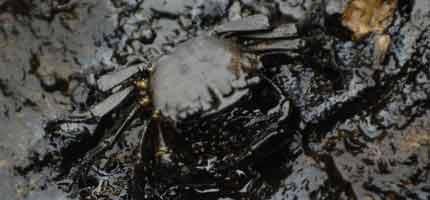
An oil-covered crab in Jounieh harbour, which is heavily polluted by oil after Israel bombed the nearby Jiyyeh power plant
Beirut, Lebanon: Large amounts of the huge oil slick off the Lebanese coast has now sunk to the sea bed, creating a thick carpet of heavy fuel oil up to 10 cm thick, which is suffocating sea life, Greenpeace revealed today.
An estimated 10,000 to 15,000 tonnes of Fuel Oil 150 (1) poured into the Mediterranean Sea following the bombing of the Jieh power plant by Israel on July 13 and 15. This has contaminated up to 30 areas along 150 km of the Lebanese coast north of Jieh; the full extent of the spill has yet to be fully assessed as aerial surveillance is still difficult due to an air and sea blockade. A satellite map of the affected area can be seen here.
At a press conference in Beirut, Greenpeace and the Lebanese Union of Professional Divers screened previously unseen video footage showing the underwater oil slick covering an area stretching over 100 metres to the West and in places dozens of meters to the North and South of the site of the leak. The newly-discovered oil on the seabed could be brought back to the surface with currents and winds and could lead to further contamination of the coastline.
"The scene is horrific, the seabed is completely covered with fuel oil which will threaten marine life for many years to come if it is not contained and removed immediately" said Mohammed El-Sarji, Greenpeace activist and head of the Lebanese Union of Professional Divers who conducted several dives in Jieh.
Oil spill expert Professor Rick Steiner from the University of Alaska, who is in Beirut advising the Lebanese government and various non-governmental organisations commented: "This might the first time ever that seabed contamination has been documented this clearly. The oil is extensive and very toxic and we need to find a way to save the marine environment."
Greenpeace reiterated its call for a thorough investigation and analysis of the impact of the oil spill, along with other environmental casualties of the conflict. Zeina Al Hajj, Greenpeace co-ordinator in Beirut commented "The images are alarming and it is clear that a full assessment of the extent of the oil spill will need underwater investigation along the coast as well as aerial and ground surveillance; the blockade must be lifted for this work to proceed. More effort is needed to recover as much oil as possible from contaminated areas. A full damage assessment must be carried out to cover all the environmental impacts caused by the war and, as a priority, caused by this spill."
Response to the spill was delayed due to the war and oil recovery and mitigation only started five weeks after the spill occurred. Even now, only a limited response is possible due to difficulties in getting more equipment and expertise into the area, contributing to further contamination.
Greenpeace has been working to gather information for a post conflict environmental assessment in Lebanon and will provide the authorities with the details of this seabed contamination. The organisation has offered whatever help it can provide to the regional and national authorities and will be contributing to the mitigation efforts.
Contacts:
Omer Elnaiem Greenpeace Middle East Communications Officer in Beirut, Mobile: 00961 3755100 Email: oelnaiem@diala.greenpeace.org
Zeina Al Hajj, Greenpeace International Co-ordinator in Beirut, Mobile: 00961 70990849 Email: zeina.alhajj@int.greenpeace.org
Mohammed El Sarji,, Head of the Lebanese Union of professional Divers, Mobile: 00961 3665589
Basma Badran Greenpeace Middle East spokesperson in Beirut, Mobile: 00961 3797449 Email: bbadran@diala.greenpeace.org Paul Horsman, Greenpeace International project leader in Istanbul 00 905 392780467
Isabel Leal, Greenpeace International in Amsterdam, Mobile: 00 34 647 241502
Images and footage are available upon request; please contact Hester Van Meurs from Greenpeace International in Amsterdam, tel. 00 31 20 718 2090
Notes:
(1) Fuel Oil 150 is a slightly less dense and less viscous heavy fuel oil than standard bunker fuel 180. It is probably a blend of bunker fuel and lighter diesel fractions. Fuel oil 150 is considered to be slightly more toxic than the 180 and would lose a higher percentage of these lighter fractions over time through volatilisation to the air.
Once oil is in the sea, the so-called lighter (more volatile) parts or fractions are lost through evaporation, degradation and dispersion, especially in warm waters, such that they should present less of an acute toxicity problem. However, it is still possible for these fractions to cause tainting of fish and shellfish, even when they are present at relatively low concentrations. Other more soluble compounds or chemicals are formed as partial breakdown products as the oil starts breaking into smaller droplets and is attacked by microbes that are able to digest the oil.

